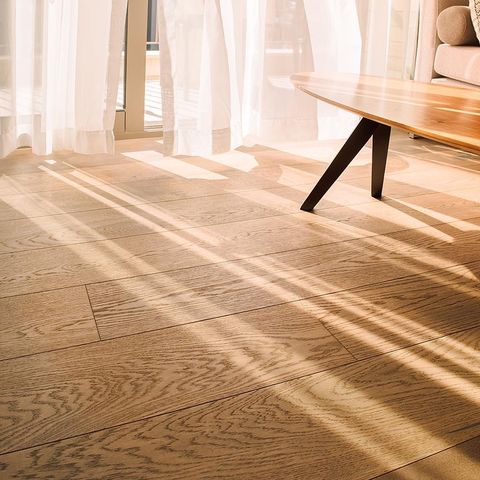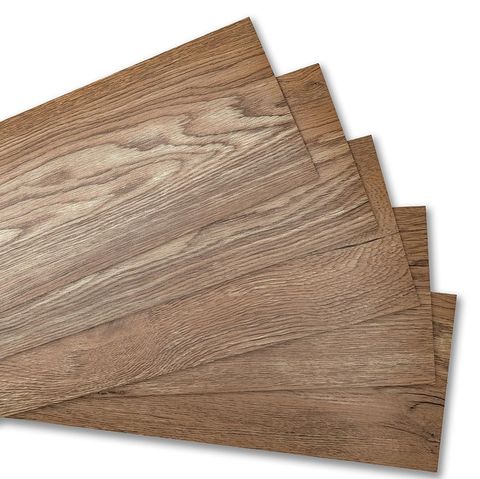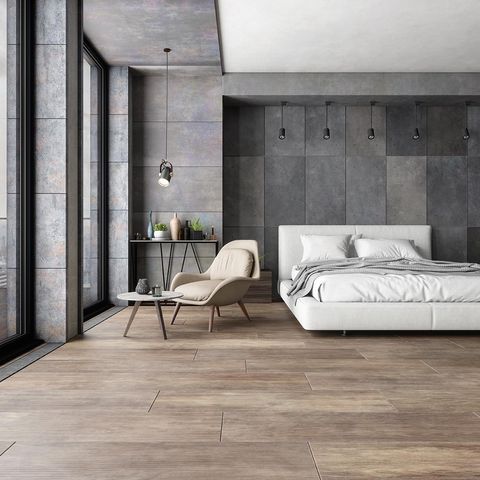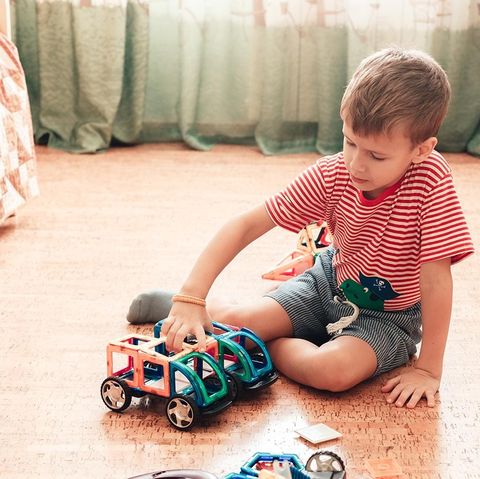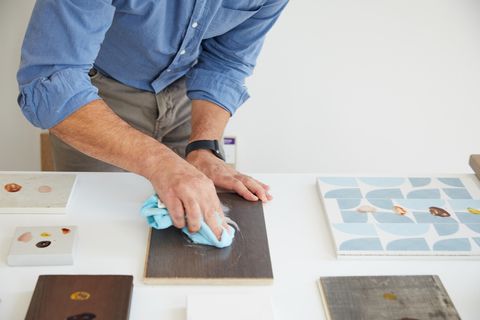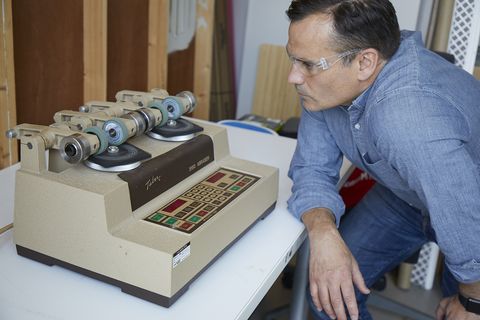
[ad_1]
Few features in the home combine form and function quite like flooring. You literally walk all over it, yet it’s also a crucial design element, every bit as visually impactful as paint colors and furniture. Then there’s the size of the investment, especially if you’re redoing the floors throughout your entire home. “It’s not far behind the cost of a new car or all new kitchen appliances, but most people aren’t armed with nearly as much information,” says Carol Swedlow, President of Aronson’s Floor Covering, which has been selling all manner of flooring out of its New York City showroom since 1867.
The Good Housekeeping Institute has been around since 1900, and our experts have long appreciated the importance of flooring to a home’s look and functionality. We’ve rigorously tested timeless materials like wood and stone, along with newer alternatives like vinyl and engineered wood flooring, both of which came about in the 1970s. More recently, our experts have followed the rise in popularity of even more materials, including concrete and wood-look porcelain.
Our ultimate flooring guide walks you through all the options, including pros, cons and basic pricing information for the best types of flooring for your home. Keep in mind that most houses feature multiple flooring materials, depending on the room and your needs. Our advice on that front hasn’t changed in over a hundred years: Spend more on the high-traffic, high-visibility areas of your home, and choose lower-cost, durable materials everywhere else.
Hardwood Flooring
There are two main types of hardwood flooring: solid wood flooring, which as the name implies consists of a one solid piece of wood, and engineered wood flooring, in which a thin veneer of real wood is bonded to layers of structural plywood. Both types come in up to fifty species, with some of the most popular options being oak, ash, maple and walnut.
- Pros: The warmth and beauty of hardwood flooring explains its enduring appeal. Since the material can be sanded and refinished multiple times (especially solid wood versions) a well-maintained hardwood floor can last for decades, or even centuries.
- Cons: The biggest downside is cost. Though some species are less expensive than others, wood flooring tends to be the most expensive. It’s also subject to dents and scratches, plus solid flooring in particular will expand and contract with changes in humidity levels, leading to cracks, splinters and squeaky boards (engineered flooring does much better with moisture, making it suitable to kitchens and basements).
- Cost: Solid wood flooring, $5 to $10 per square foot, installed; Engineered wood flooring, $4 to $9 per square foot, installed.
Laminate Flooring
Laminate is another engineered product, though instead of a veneer of wood on top, it uses a photo of wood (or stone or any other material) and adds a protective plastic coating. The substrate of laminate flooring typically consists of dense fiberboard.
- Pros: The plastic topcoat is extremely resistant to scratches and dents, making laminate one of the most durable flooring options. It’s also among the least expensive and it often comes as a DIY-friendly “floating” floor system, with planks that snap together, instead of having to be nailed or glued down.
- Cons: Not many people will mistake laminate flooring for real wood or stone. It tends to have a plastic feel and sound underfoot, and the repetition of patterns can give away its fakeness. Laminate can never be refinished, so it’s not a forever floor. And the use of formaldehyde and other chemicals in the manufacturing process makes it a less healthy and less sustainable choice.
- Cost: $3 to $7 per square foot, installed.
Vinyl Flooring
Also known as resilient flooring, vinyl is the fastest-growing category of flooring. It ranges from inexpensive, DIY-friendly peel-and-stick tiles to so-called luxury vinyl tile (or LVT, for short) which consists of multiple layers, including a design layer with a high-definition printed image, a durable top layer and several cushion layers.
- Pros: Entry-level sheet vinyl is very affordable. All vinyl resists stains, scratches and dents, plus its waterproof, making it safe for basements and bathrooms. Installation is easy, particularly for adhesive tiles and floating planks. LVT is a thick, sturdy tile that has the look and feel of real wood. In fact, our product experts often have trouble distinguishing LVT from solid wood in tests.
- Cons: Though patterns and color options have improved, even LVT is still a far cry from real wood or stone, so it will never pass muster with the purists. It can’t be refinished, meaning once it does begin to wear out, the only choice is a full replacement. LVT is also surprisingly expensive, often rivaling the cost of real wood.
- Cost: $2 to $6 per square foot, installed.
Carpet
Though carpet has been losing market share to resilient flooring, it’s still the biggest flooring category in the U.S. Most carpet sold in this country is tufted, with small, usually nylon fibers poking up through a backing that’s typically made of polyurethane. Then there’s woven carpet, which is more common in Europe and is made by weaving lengths of yarn that is usually made of wool. Woven carpet is several times more expensive than tufted carpet.
- Pros: Carpet is the most comfortable and cost-effective flooring material and it’s available in a wide range of colors and patterns. It installs easily and carpet is easy to maintain, requiring just regular vacuuming. Stain-resistant versions are even easier to keep clean.
- Cons: The main knock against carpet is that it holds dirt and dust, which can be particularly unpleasant for allergy sufferers. Woven carpet is much better at resisting this, since its construction doesn’t create places for dirt to hide. Wool is also anti-static, so it doesn’t attract dust the way nylon tufted carpets will.
- Cost: $3 to $10 per square foot, installed.
Stone Flooring
Like wood, stone is another timeless flooring material that almost always adds value to the home. Three types of stone are used for flooring. Sedimentary stones like travertine and limestone are formed by layers of dissolved minerals and marine organism. Igneous stone like granite is the result of extreme heat and volcanic action. Metamorphic stone like marble and slate has changed from one state to another under extreme heat and pressure.
- Pros: Because no two stones are the same, stone flooring has tons of character and uniqueness. Stone is also a durable material that can withstand heavy foot traffic and fading under intense sunlight. It also keeps the dust and allergens at bay.
- Cons: You’ll pay a premium for most stone flooring and it requires professional installation. Stone floors aren’t soft underfoot and dropped dish ware is almost certain to break when dropped on it. Many types of stone floors require sealing to resist stains.
- Cost: $3 to $7 per square foot, installed.
Concrete Flooring
This basic building material has been seized by high-end builders and designers as a fashion-forward material for floors, as well as kitchen countertops. A poured-in-place concrete floor can be the expected shade of institutional gray or it can be colored with dyes. It can also take on different surface treatments, from acid stains to rubber-stamp stencils, creating a truly one-of-a-kind effect.
- Pros: Besides its uniqueness, concrete floors are durable and easy to maintain, assuming they’re properly sealed during installation. The material conducts heat well, so concrete floors are a good option if you’re planning on radiant heating, whereby hot water tubes are embedded in the floors during the installation process.
- Cons: Since it’s basically a custom product, concrete floors are pricey and require professional installation. The rock-hard material is also unforgiving, and it needs to be resealed every year or so to prevent stains.
- Cost: $3 to $8 per square foot, installed
Tile Flooring
There are two main types of tile flooring: ceramic and porcelain. Ceramic is typically made from a mixture of water and sand, making it softer yet more affordable. Porcelain is made from a finer, denser clay and fired at a higher temperature, so it’s naturally harder and less porous.
- Pros: Tile floors have a classic look and they’ll available in countless colors and design configurations, from mosaic to large-format tiles with minimal grout lines. All tile is water-proof and low-maintenance. Porcelain tile is extremely hard-wearing and resistant to scratches and dents.
- Cons: Difficult installation is the biggest drawback. The tiles are typically laid in mortar over a smooth, stable substrate; unless you’re a very experienced DIYer, the project is best left to a professional. Porcelain tile is also on the pricey side, ab0ut the same as solid wood flooring.
- Cost: $4 to $15 per square foot, installed.
Cork Flooring
Another niche flooring product, cork is a renewable material that’s made from harvesting the bark of cork trees. It has its fans (Swedlow calls it “the best stuff on earth”), but it’s a category with a particularly wide range in quality, so it’s best to source it from a specialized flooring dealer who can help steer you to a top-performing line.
- Pros: Cork’s light, airy quality makes it one of the most comfortable flooring materials. It’s also water-resistant and doesn’t become slippery when wet, making it suitable to kitchens and bathrooms. Cork is non-toxic and eco-friendly.
- Cons: The material is prone to fading under intense sunlight. Cheaper versions will damage easily, showing scratches from heavy foot traffic, furniture and pets.
- Cost: $5 to $14 per square foot, installed.
Linoleum Flooring
This all-natural flooring is made from linseed oil and wood products. Like vinyl, it is sold in tiles or sheets, though it’s not nearly as common as its resilient cousin. “It tends to be a more sophisticated customer who is putting linoleum in their kitchen, bathroom, or maybe a new home gym,” says Swedlow.
- Pros: The sustainable appeal is a huge selling point, along with linoleum’s uniqueness and retro charm. The latest versions come in many more styles and colors than years past. Linoleum also has a softness underfoot that makes it very comfortable, and it resists fading from sunlight.
- Cons: Linoleum is not as durable as vinyl. It’s prone to wearing under heavy foot traffic and it can scratch and dent easily. Applying a wax finish will help protect the surface, but that adds to the maintenance.
- Cost: $3 to $7 per square foot, installed.
How we chose the best flooring
Our experts are always paying attention to the marketplace to identify the flooring materials you’re most likely to find at home centers, independent showrooms and online. We also regularly attend trade shows and industry events, including Surfaces, the Kitchen & Bath Industry Show (KBIS), and the International Builders Show, to keep up with all the latest trends and innovations.
When it comes to hands-on testing, we focus on brands with a proven track record for performance and reliability. In our Labs, we run stain tests to determine how well a material resists mustard, wine and the like. We also run abrasion tests to make sure materials can withstand scratches and drop tests to measure their resistance to dings and dents. Our engineers review technical data from the manufacturers related to performance, safety and sustainability. Finally, whenever possible, we use the flooring materials for actual installations at consumer testers’ homes to see how they perform under real-world conditions.
What to consider when choosing flooring for your home?
Many homeowners focus on the look and price of flooring, without thinking through what it will be like to live with the material over the long term. Here are the factors you need to weigh to make the smart decision.
✔️ Comfort: What will it be like standing on the floor for long stretches of time? Flooring materials that offer a softness underfoot, like cork and vinyl tile, will be much more comfortable than those that are rock hard, like concrete, stone and porcelain. Especially in rooms where you do a lot of standing — think kitchen and laundry room, for example —comfort is critical.
✔️ Maintenance: Most floors look fabulous when they’re first installed. How hard are you going to have to work to keep them looking that way for years and even decades? Vinyl, laminate and engineered wood are extremely easy to care for. Materials that need to be sealed, like stone and linoleum, are much higher maintenance.
✔️ Health and sustainability: Some floors are better for you and for the planet. As a rule, the fewer synthetic materials they contain, the better. That’s why solid wood flooring is a better option than engineered or laminate. Likewise, all-natural linoleum and cork are superior to vinyl. Wood flooring certified by the Forest Stewardship Council and the Sustainable Forestry Initiative comes from responsibly managed forests. Resilient flooring with the industry’s FloorScore certification will off-gas relatively low levels of volatile organic compound, or VOCs.
What’s the best place to shop for flooring?
Flooring in all its various forms is primarily sold at home centers and specialty flooring retailers. If you’re working with a contractor or installer, it probably makes sense to purchase your flooring through them, since they’ll get it at a lower professional rate. Be sure to leave plenty of lead time. “Like most things these days, the flooring industry is experiencing some challenges with the supply chain,” says Brett Miller of National Wood Flooring Association (NWFA).
Inflation and supply chain issues are making it harder to price out the project. “Costs for hardwood flooring like oak and maple are still elevated, with manufacturers facing prices 38% higher than at the start of the pandemic,” explains Mischa Fisher, chief economist at ANGI, the home services provider. “Because of the price volatility, it’s always a good idea for consumers to shop around for multiple prices and quotes from installers. Periods of high volatility may produce a wide range of possible prices in the market.”
Here are the top places to shop:
✔️ Home Depot: With some 2,300 locations nationwide, the biggest home center carries a wide range of flooring materials at competitive prices. Whether you want solid, engineered, laminate or faux-wood flooring, you’ll find it at the Home Depot, along with various financing options and installation services.
✔️ Lowe’s: The country’s second biggest home center is another safe bet for all kinds of wood flooring. Its service offerings are even more robust, including in-home flooring measurements, design consults, professional installation and free shipping on flooring samples.
✔️ LL Flooring: Formerly known as Lumber Liquidators, LL Flooring has more than 400 locations across 47 states, plus an excellent website that makes it easy to find the right flooring and receive up to four free samples. In 2015, the company announced that it would stop selling vinyl flooring with phthalates; today its vendors are required to meet stringent GREENGUARD Gold or FloorScore certification standards for indoor air quality.
✔️ Floor & Décor:Though LL Flooring has the most locations, Floor & Décor sells the most flooring, so you’re guaranteed to find a wide selection of floors at all price points. The site has an extensive library of virtual how-to clinics, for those looking to save by installing their flooring themselves.
✔️ Independent dealers: Specialty retailers like Aronsons tend to have very knowledgeable salespeople, along with a network of installers, so they can guide you through every step of the process. However, they tend to cater to higher-end customers, making them less ideal for budget shopper.
✔️ Local mills: If you’re in the market for wood floors, buying direct from your local lumber mills cuts out the middleman, leading to potentially better prices. Also, most mills will let you see the manufacturing process, so you know exactly what you’re getting and also where the wood is sourced.
Why trust Good Housekeeping?
The Good Housekeeping Institute Home Improvement Lab provides expert reviews and advice on all things home-related, including the best paints for cabinets, decking materials and more. As the director of the Home Improvement & Outdoor Lab, Dan DiClerico brings more than 20 years of experience to the Institute, reviewing thousands of products for Good Housekeeping and previously for This Old House and Consumer Reports. He has also helped install and restore many floors over the years — most recently, the hardwood floors at his own home in Brooklyn, NY.
For this report, Dan worked closely with the Institute’s Chief Technologist & Director of Engineering Rachel Rothman, who oversaw the testing protocol for flooring. For more than 15 years, Rachel has put her training in mechanical engineering and applied mathematics to work by researching, testing and writing about products across the home improvement space. Like Dan, she has plenty of real-world experience, both with her own projects and those she advises on at the homes of consumer testers.
Having written thousands of product reviews and how-to articles on all aspects of home ownership, from routine maintenance to major renovations, Dan (he/him) brings more than 20 years of industry experience to his role as the director of the Home Improvement & Outdoor Lab at the Good Housekeeping Institute. A one-time roofer and a serial remodeler, Dan can often be found keeping house at his restored Brooklyn brownstone, where he lives with his wife and kids.
This content is imported from OpenWeb. You may be able to find the same content in another format, or you may be able to find more information, at their web site.
[ad_2]
Source link

